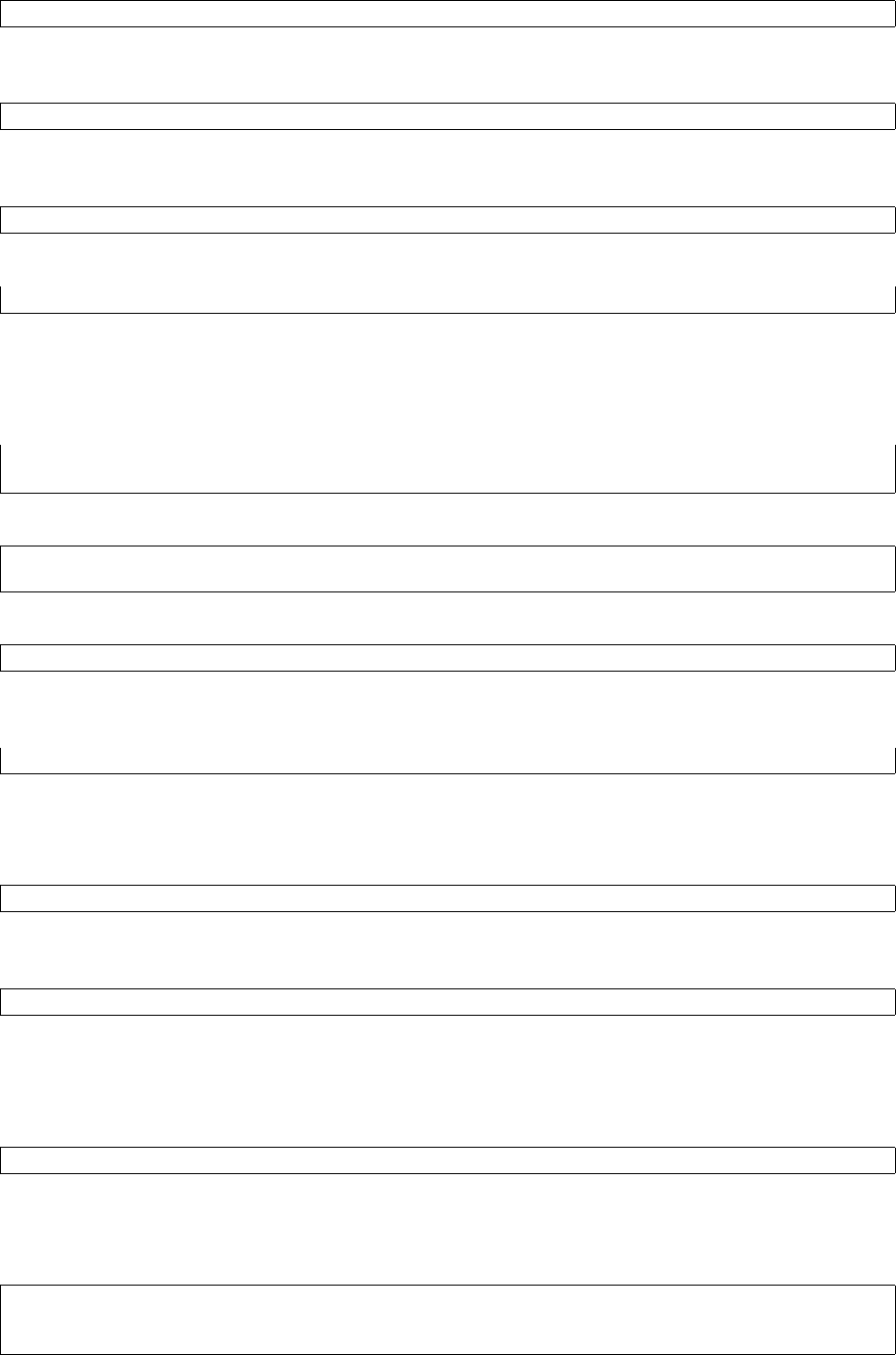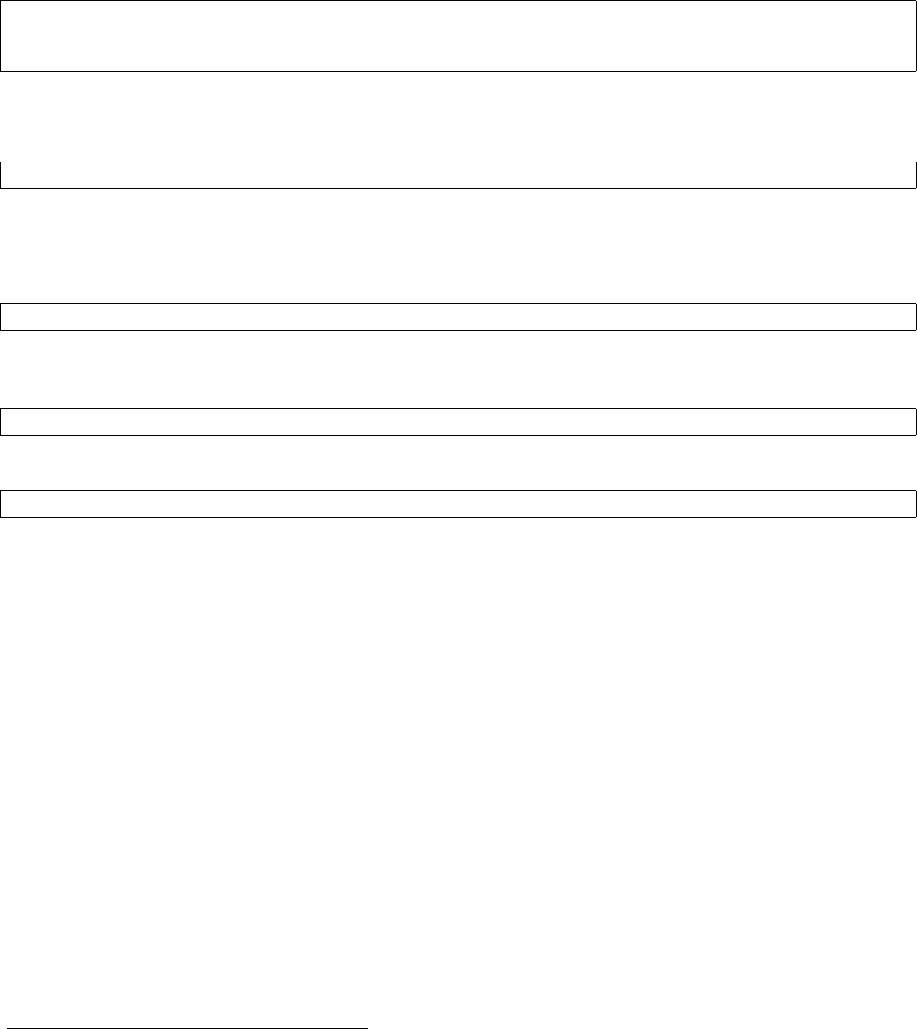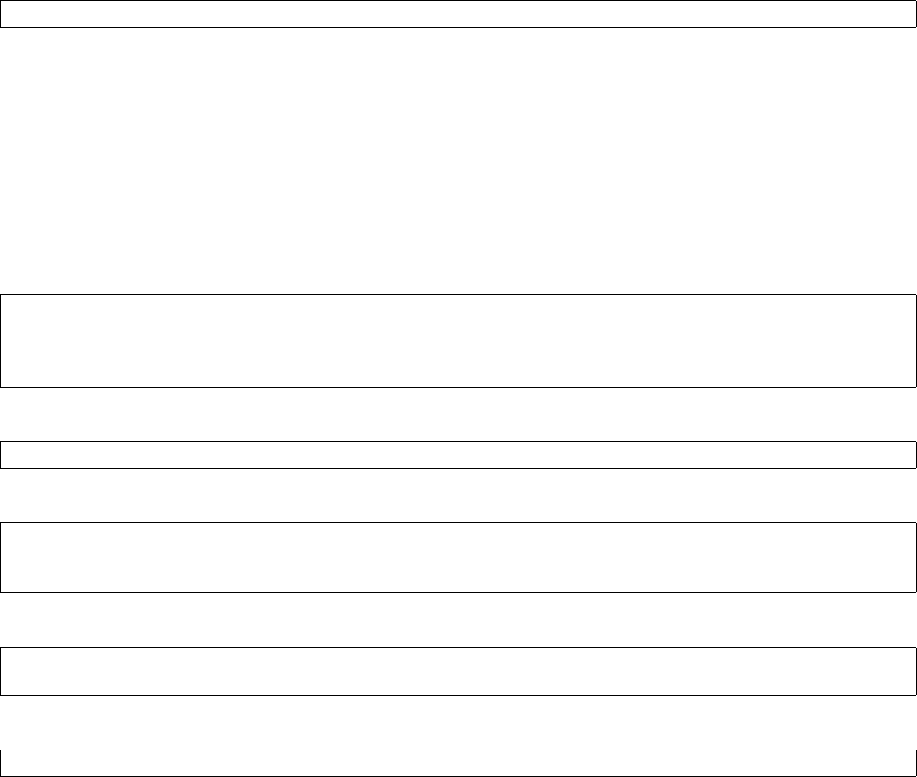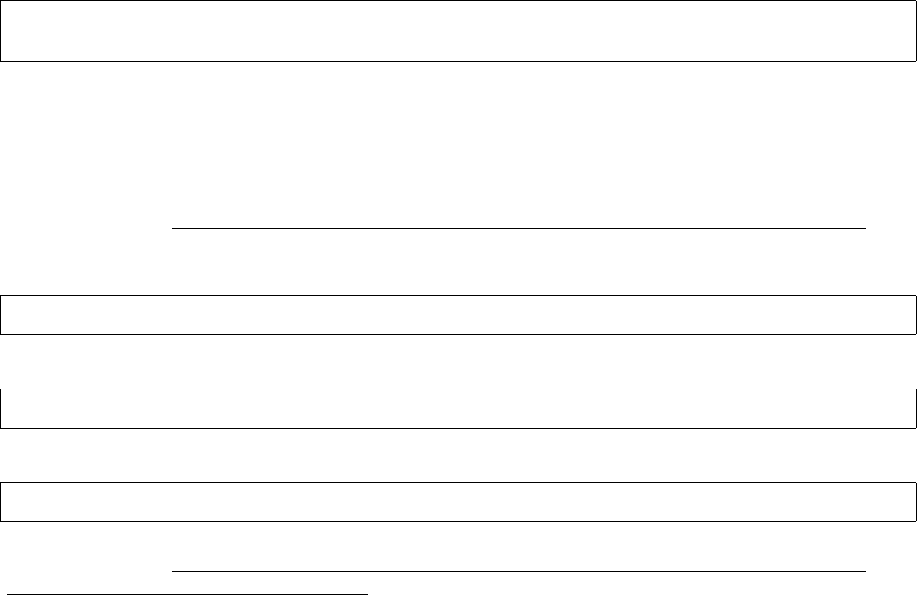
python-sounddevice
Release 0.3.2
Matthias Geier
March 16, 2016
Contents
1 Requirements 1
2 Installation 2
3 Usage 2
3.1 Playback . . . . . . . . . . . . . . . . . . . . . . . . . . . . . . . . . . . . . . . . . . . . . . . . 2
3.2 Recording . . . . . . . . . . . . . . . . . . . . . . . . . . . . . . . . . . . . . . . . . . . . . . . 3
3.3 Simultaneous Playback and Recording . . . . . . . . . . . . . . . . . . . . . . . . . . . . . . . . 3
3.4 Device Selection . . . . . . . . . . . . . . . . . . . . . . . . . . . . . . . . . . . . . . . . . . . 3
3.5 Callback Streams . . . . . . . . . . . . . . . . . . . . . . . . . . . . . . . . . . . . . . . . . . . 4
3.6 Blocking Read/Write Streams . . . . . . . . . . . . . . . . . . . . . . . . . . . . . . . . . . . . 4
4 Contributing 4
5 API Documentation 5
6 Version History 21
This Python
1
module provides bindings for the PortAudio
2
library and a few convenience functions to play and
record NumPy
3
arrays containing audio signals.
Documentation: http://python-sounddevice.rtfd.org/
Code: http://github.com/spatialaudio/python-sounddevice/
Python Package Index: http://pypi.python.org/pypi/sounddevice/
License: MIT – see the file LICENSE for details.
1 Requirements
Python: Of course, you’ll need Python
4
. Any version where CFFI (see below) is supported should work. If you
don’t have Python installed yet, you should get one of the distributions which already include CFFI and
1
http://www.python.org/
2
http://www.portaudio.com/
3
http://www.numpy.org/
4
http://www.python.org/

NumPy (and many other useful things), e.g. Anaconda
5
or WinPython
6
.
pip/setuptools: Those are needed for the installation of the Python module and its dependencies. Most systems
will have these installed already, but if not, you should install it with your package manager or you can
download and install pip and setuptools as described on the pip installation
7
page. If you happen to have
pip but not setuptools, use this command:
pip install setuptools --user
CFFI: The C Foreign Function Interface for Python
8
is used to access the C-API of the PortAudio library from
within Python. It supports CPython 2.6, 2.7, 3.x; and is distributed with PyPy
9
2.0 beta2 or later. If
it’s not installed already, you should install it with your package manager (the package might be called
python3-cffi, python-cffi or similar), or you can get it with:
pip install cffi --user
PortAudio library: The PortAudio
10
library must be installed on your system (and CFFI must be able to find it).
Again, you should use your package manager to install it (the package might be called libportaudio2
or similar). If you prefer, you can of course also download the sources and compile the library yourself. If
you are using Mac OS X or Windows, the library will be installed automagically with pip (see “Installation”
below).
NumPy (optional): NumPy
11
is only needed if you want to play back and record NumPy ar-
rays. The classes sounddevice.RawStream, sounddevice.RawInputStream and
sounddevice.RawOutputStream use plain Python buffer objects and don’t need NumPy at
all. If you need NumPy, you should install it with your package manager or use a Python distribution that
already includes NumPy (see above). Installing NumPy with pip is not recommended.
2 Installation
Once you have installed the above-mentioned dependencies, you can use pip to download and install the latest
release with a single command:
pip install sounddevice --user
If you want to install it system-wide for all users (assuming you have the necessary rights), you can just drop the
--user option.
To un-install, use:
pip uninstall sounddevice
3 Usage
First, import the module:
import sounddevice as sd
3.1 Playback
Assuming you have a NumPy array named myarray holding audio data with a sampling frequency of fs (in the
most cases this will be 44100 or 48000 frames per second), you can play it back with sounddevice.play():
5
http://docs.continuum.io/anaconda/
6
http://winpython.github.io/
7
http://www.pip-installer.org/en/latest/installing.html
8
http://cffi.readthedocs.org/
9
http://pypy.org/
10
http://www.portaudio.com/
11
http://www.numpy.org/

sd.play(myarray, fs)
This function returns immediately but continues playing the audio signal in the background. You can stop playback
with sounddevice.stop():
sd.stop()
If you know that you will use the same sampling frequency for a while, you can set it as default using
sounddevice.default.samplerate:
sd.default.samplerate = fs
After that, you can drop the samplerate argument:
sd.play(myarray)
3.2 Recording
To record audio data from your sound device into a NumPy array, use sounddevice.rec():
duration = 10 # seconds
myrecording = sd.rec(duration
*
fs, samplerate=fs, channels=2)
Again, for repeated use you can set defaults using sounddevice.default:
sd.default.samplerate = fs
sd.default.channels = 2
After that, you can drop the additional arguments:
myrecording = sd.rec(duration
*
fs)
This function also returns immediately but continues recording in the background. In the meantime, you can run
other commands. If you want to check if the recording is finished, you should use sounddevice.wait():
sd.wait()
If the recording was already finished, this returns immediately; if not, it waits and returns as soon as the recording
is finished.
Alternatively, you could have used the blocking argument in the first place:
myrecording = sd.rec(duration
*
fs, blocking=True)
By default, the recorded array has the data type ’float32’ (see sounddevice.default.dtype), but this
can be changed with the dtype argument:
myrecording = sd.rec(duration
*
fs, dtype='float64')
3.3 Simultaneous Playback and Recording
To play back an array and record at the same time, use sounddevice.playrec():
myrecording = sd.playrec(myarray, fs, channels=2)
The number of output channels is obtained from myarray, but the number of input channels still has to be
specified.
Again, default values can be used:
sd.default.samplerate = fs
sd.default.channels = 2
myrecording = sd.playrec(myarray)

In this case the number of output channels is still taken from myarray (which may or may not have 2 channels),
but the number of input channels is taken from sounddevice.default.channels.
3.4 Device Selection
In many cases, the default input/output device(s) will be the one(s) you want, but it is of course possible to choose
a different device. Use sounddevice.query_devices() to get a list of supported devices. The same list
can be obtained from a terminal by typing the command
python -m sounddevice
You can use the corresponding device ID to select a desired device by assigning to
sounddevice.default.device or by passing it as device argument to sounddevice.play(),
sounddevice.Stream() etc.
Instead of the numerical device ID, you can also use a space-separated list of case-insensitive substrings of the
device name (and the host API name, if needed). See sounddevice.default.device for details.
import sounddevice as sd
sd.default.samplerate = 44100
sd.default.device = 'digital output'
sd.play(myarray)
3.5 Callback Streams
Callback “wire” with sounddevice.Stream:
import sounddevice as sd
duration = 5 # seconds
def callback(indata, outdata, frames, time, status):
if status:
print(status, flush=True)
outdata[:] = indata
with sd.Stream(channels=2, callback=callback):
sd.sleep(duration
*
1000)
Same thing with sounddevice.RawStream:
import sounddevice as sd
duration = 5 # seconds
def callback(indata, outdata, frames, time, status):
if status:
print(status, flush=True)
outdata[:] = indata
with sd.RawStream(channels=2, dtype='int24', callback=callback):
sd.sleep(duration
*
1000)
Note: We are using 24-bit samples here for no particular reason (just because we can).
3.6 Blocking Read/Write Streams
Instead of using a callback function, you can also use the blocking methods sounddevice.Stream.read()
and sounddevice.Stream.write() (and of course the corresponding methods in

sounddevice.InputStream, sounddevice.OutputStream, sounddevice.RawStream,
sounddevice.RawInputStream and sounddevice.RawOutputStream).
4 Contributing
If you find bugs, errors, omissions or other things that need improvement, please create an issue or a pull request
at http://github.com/spatialaudio/python-sounddevice/. Contributions are always welcome!
Instead of pip-installing the latest release from PyPI, you should get the newest development version from
Github
12
:
git clone --recursive https://github.com/spatialaudio/python-sounddevice.git
cd python-sounddevice
python setup.py develop --user
This way, your installation always stays up-to-date, even if you pull new changes from the Github repository.
If you prefer, you can also replace the last command with:
pip install --user -e .
... where -e stands for --editable.
If you used the --recursive option when cloning, the dynamic libraries for Mac OS X and Windows should
be available. If not, you can get the submodule with:
git submodule update --init --recursive
If you make changes to the documentation, you can re-create the HTML pages using Sphinx
13
. You can install it
and a few other necessary packages with:
pip install -r doc/requirements.txt --user
To create the HTML pages, use:
python setup.py build_sphinx
The generated files will be available in the directory build/sphinx/html/.
5 API Documentation
Play and Record Sound with Python.
http://python-sounddevice.rtfd.org/
sounddevice.play(data, samplerate=None, mapping=None, blocking=False, **kwargs)
Play back an array of audio data.
Parameters
• data (array_like) – Audio data to be played back. The columns of a two-dimensional
array are interpreted as channels, one-dimensional arrays are treated as mono data. The
data types float64, float32, int32, int16, int8 and uint8 can be used. float64 data is
converted to float32 before passing it to PortAudio, because it’s not supported natively.
• mapping (array_like, optional) – List of channel numbers (starting with 1) where the
columns of data shall be played back on. Must have the same length as number of chan-
nels in data (except if data is mono). Each channel may only appear once in mapping.
12
http://github.com/spatialaudio/python-sounddevice/
13
http://sphinx-doc.org/

• blocking (bool, optional) – If False (the default), return immediately (but playback
continues in the background), if True, wait until playback is finished. A non-blocking
invocation can be stopped with stop() or turned into a blocking one with wait().
Other Parameters samplerate, **kwargs – All parameters of OutputStream (except chan-
nels, dtype, callback and finished_callback) can be used.
See also:
rec(), playrec()
sounddevice.rec(frames=None, samplerate=None, channels=None, dtype=None, out=None, map-
ping=None, blocking=False, **kwargs)
Record audio data.
Parameters
• frames (int, sometimes optional) – Number of frames to record. Not needed if out is
given.
• channels (int, optional) – Number of channels to record. Not needed if mapping or out
is given. The default value can be changed with default.channels.
• dtype (str or numpy.dtype, optional) – Data type of the recording. Not needed if out
is given. The data types float64, float32, int32, int16, int8 and uint8 can be used. For
dtype=’float64’, audio data is recorded in float32 format and converted afterwards, be-
cause it’s not natively supported by PortAudio. The default value can be changed with
default.dtype.
• mapping (array_like, optional) – List of channel numbers (starting with 1) to record.
If mapping is given, channels is silently ignored.
• blocking (bool, optional) – If False (the default), return immediately (but recording
continues in the background), if True, wait until recording is finished. A non-blocking
invocation can be stopped with stop() or turned into a blocking one with wait().
Returns
numpy.ndarray or type(out) – The recorded data.
Note: By default (blocking=False), an array of data is returned which is still being
written to while recording. The returned data is only valid once recording has stopped. Use
wait() to make sure the recording is finished.
Other Parameters
• out (numpy.ndarray or subclass, optional) – If out is specified, the recorded data is
written into the given array instead of creating a new array. In this case, the arguments
frames, channels and dtype are silently ignored! If mapping is given, its length must
match the number of channels in out.
• samplerate, **kwargs – All parameters of InputStream (except callback and fin-
ished_callback) can be used.
See also:
play(), playrec()
sounddevice.playrec(data, samplerate=None, channels=None, dtype=None, out=None, in-
put_mapping=None, output_mapping=None, blocking=False, **kwargs)
Simultaneous playback and recording.
Parameters
• data (array_like) – Audio data to be played back. See play().

• channels (int, sometimes optional) – Number of input channels, see rec(). The num-
ber of output channels is obtained from data.shape.
• dtype (str or numpy.dtype, optional) – Input data type, see rec(). If dtype is not
specified, it is taken from data.dtype (i.e. default.dtype is ignored). The output
data type is obtained from data.dtype anyway.
• input_mapping, output_mapping (array_like, optional) – See the parameter mapping
of rec() and play(), respectively.
• blocking (bool, optional) – If False (the default), return immediately (but continue
playback/recording in the background), if True, wait until playback/recording is fin-
ished. A non-blocking invocation can be stopped with stop() or turned into a block-
ing one with wait().
Returns numpy.ndarray or type(out) – The recorded data. See rec().
Other Parameters
• out (numpy.ndarray or subclass, optional) – See rec().
• samplerate, **kwargs – All parameters of Stream (except channels, dtype, callback
and finished_callback) can be used.
See also:
play(), rec()
sounddevice.wait()
Wait for play()/rec()/playrec() to be finished.
Playback/recording can be stopped with a KeyboardInterrupt
14
.
Returns CallbackFlags or None – If at least one buffer over-/underrun happened during the last
playback/recording, a CallbackFlags object is returned.
See also:
get_status()
sounddevice.stop(ignore_errors=True)
Stop playback/recording.
This only stops play(), rec() and playrec(), but has no influence on streams created with Stream,
InputStream, OutputStream, RawStream, RawInputStream, RawOutputStream.
sounddevice.get_status()
Get information about over-/underflows in play()/rec()/playrec().
Returns CallbackFlags – A CallbackFlags object that holds information about the last
invocation of play(), rec() or playrec().
See also:
wait()
sounddevice.query_devices(device=None, kind=None)
Return information about available devices.
Information and capabilities of PortAudio devices. Devices may support input, output or both input and
output.
To find the default input/output device, use default.device.
Parameters
• device (int or str, optional) – Numeric device ID or device name substring(s). If speci-
fied, information about only the given device is returned in a single dictionary.
14
http://docs.python.org/3/library/exceptions.html#KeyboardInterrupt

• kind ({‘input’, ‘output’}, optional) – If device is not specified and kind is ’input’ or
’output’, a single dictionary is returned with information about the default input or
output device, respectively.
Returns
dict or DeviceList – A dictionary with information about the given device or – if no device
was specified – a DeviceList containing one dictionary for each available device. The
dictionaries have the following keys:
’name’ The name of the device.
’hostapi’ The ID of the corresponding host API. Use query_hostapis() to get
information about a host API.
’max_input_channels’, ’max_output_channels’ The maximum number of
input/output channels supported by the device. See default.channels.
’default_low_input_latency’, ’default_low_output_latency’
Default latency values for interactive performance. This is used if
default.latency (or the latency argument of playrec(), Stream etc.)
is set to ’low’.
’default_high_input_latency’, ’default_high_output_latency’
Default latency values for robust non-interactive applications (e.g. playing sound
files). This is used if default.latency (or the latency argument of playrec(),
Stream etc.) is set to ’high’.
’default_samplerate’ The default sampling frequency of the device. This is used
if default.samplerate is not set.
Notes
The list of devices can also be displayed in a terminal:
python -m sounddevice
Examples
The returned DeviceList can be indexed and iterated over like a normal tuple
15
(yielding the above-
mentioned dictionaries), but it also has a special string representation which is shown when used in an
interactive Python session.
Each available device is listed on one line together with the corresponding device ID, which can be assigned
to default.device or used as device argument in play(), Stream etc.
The first character of a line is > for the default input device, < for the default output device and
*
for the
default input/output device. After the device ID and the device name, the corresponding host API name is
displayed. In the end of each line, the maximum number of input and output channels is shown.
On a GNU/Linux computer it might look somewhat like this:
>>> import sounddevice as sd
>>> sd.query_devices()
0 HDA Intel: ALC662 rev1 Analog (hw:0,0), ALSA (2 in, 2 out)
1 HDA Intel: ALC662 rev1 Digital (hw:0,1), ALSA (0 in, 2 out)
2 HDA Intel: HDMI 0 (hw:0,3), ALSA (0 in, 8 out)
3 sysdefault, ALSA (128 in, 128 out)
4 front, ALSA (0 in, 2 out)
5 surround40, ALSA (0 in, 2 out)
6 surround51, ALSA (0 in, 2 out)
15
http://docs.python.org/3/library/stdtypes.html#tuple

7 surround71, ALSA (0 in, 2 out)
8 iec958, ALSA (0 in, 2 out)
9 spdif, ALSA (0 in, 2 out)
10 hdmi, ALSA (0 in, 8 out)
*
11 default, ALSA (128 in, 128 out)
12 dmix, ALSA (0 in, 2 out)
13 /dev/dsp, OSS (16 in, 16 out)
Note that ALSA provides access to some “real” and some “virtual” devices. The latter sometimes have a
ridiculously high number of (virtual) inputs and outputs.
On Mac OS X, you might get something similar to this:
>>> sd.query_devices()
0 Built-in Line Input, Core Audio (2 in, 0 out)
> 1 Built-in Digital Input, Core Audio (2 in, 0 out)
< 2 Built-in Output, Core Audio (0 in, 2 out)
3 Built-in Line Output, Core Audio (0 in, 2 out)
4 Built-in Digital Output, Core Audio (0 in, 2 out)
sounddevice.query_hostapis(index=None)
Return information about available host APIs.
Parameters index (int, optional) – If specified, information about only the given host API index
is returned in a single dictionary.
Returns
dict or tuple of dict – A dictionary with information about the given host API index or – if
no index was specified – a tuple containing one dictionary for each available host API. The
dictionaries have the following keys:
’name’ The name of the host API.
’devices’ A list of device IDs belonging to the host API. Use query_devices() to
get information about a device.
’default_input_device’, ’default_output_device’ The device ID of the
default input/output device of the host API. If no default input/output device exists for
the given host API, this is -1.
Note: The overall default device(s) – which can be overwritten by assigning to
default.device – take(s) precedence over default.hostapi and the infor-
mation in the abovementioned dictionaries.
See also:
query_devices()
sounddevice.check_input_settings(device=None, channels=None, dtype=None, sampler-
ate=None)
Check if given input device settings are supported.
All parameters are optional, default settings are used for any unspecified parameters. If the settings are
supported, the function does nothing; if not, an exception is raised.
Parameters
• device (int or str, optional) – Device ID or device name substring, see
default.device.
• channels (int, optional) – Number of input channels, see default.channels.
• dtype (str or numpy.dtype, optional) – Data type for input samples, see
default.dtype.

• samplerate (float, optional) – Sampling frequency, see default.samplerate.
sounddevice.check_output_settings(device=None, channels=None, dtype=None, sampler-
ate=None)
Check if given output device settings are supported.
Same as check_input_settings(), just for output device settings.
sounddevice.sleep(msec)
Put the caller to sleep for at least msec milliseconds.
The function may sleep longer than requested so don’t rely on this for accurate musical timing.
sounddevice.get_portaudio_version()
Get version information for the PortAudio library.
Returns the release number and a textual description of the current PortAudio build, e.g.
(1899, 'PortAudio V19-devel (built Feb 15 2014 23:28:00)')
class sounddevice.default
Get/set defaults for the sounddevice module.
The attributes device, channels, dtype and latency accept single values which specify the given
property for both input and output. However, if the property differs between input and output, pairs of
values can be used, where the first value specifies the input and the second value specifies the output. All
other attributes are always single values.
Examples
>>> import sounddevice as sd
>>> sd.default.samplerate = 48000
>>> sd.default.dtype
['float32', 'float32']
Different values for input and output:
>>> sd.default.channels = 1, 2
A single value sets both input and output at the same time:
>>> sd.default.device = 5
>>> sd.default.device
[5, 5]
An attribute can be set to the “factory default” by assigning None:
>>> sd.default.samplerate = None
>>> sd.default.device = None, 4
Use reset() to reset all attributes:
>>> sd.default.reset()
device = (None, None)
Index or query string of default input/output device.
If not overwritten, this is queried from PortAudio.
If a string is given, the device is selected which contains all space-separated parts in the right order.
Each device string contains the name of the corresponding host API in the end. The string comparison
is case-insensitive.
See also:
query_devices()

channels = (None, None)
Number of input/output channels.
The maximum number of channels for a given device can be found out with query_devices().
dtype = (‘float32’, ‘float32’)
Data type used for input/output samples.
The types ’float32’, ’int32’, ’int16’, ’int8’ and ’uint8’ can be used for all
streams and functions. Additionally, play(), rec() and playrec() support ’float64’
(for convenience, data is merely converted from/to ’float32’) and RawInputStream,
RawOutputStream and RawStream support ’int24’ (packed 24 bit format – not supported
in NumPy!).
If NumPy is available, the corresponding numpy.dtype
16
objects can be used as well.
The floating point representations ’float32’ and ’float64’ use +1.0 and -1.0 as the maximum
and minimum values, respectively. ’uint8’ is an unsigned 8 bit format where 128 is considered
“ground”.
latency = (‘high’, ‘high’)
Suggested input/output latency in seconds.
The special values ’low’ and ’high’ can be used to select the default low/high latency of the
chosen device. ’high’ is typically more robust (i.e. buffer under-/overflows are less likely), but the
latency may be too large for interactive applications.
See also:
query_devices()
samplerate = None
Sampling frequency in Hertz (= frames per second).
See also:
query_devices()
blocksize = 0
See the blocksize argument of Stream.
clip_off = False
Disable clipping.
Set to True to disable default clipping of out of range samples.
dither_off = False
Disable dithering.
Set to True to disable default dithering.
never_drop_input = False
Set behavior for input overflow of full-duplex streams.
Set to True to request that where possible a full duplex stream will not discard overflowed input
samples without calling the stream callback. This flag is only valid for full-duplex callback streams
(i.e. only Stream and RawStream and only if callback was specified; this includes playrec())
and only when used in combination with blocksize=0 (the default). Using this flag incorrectly results
in an error being raised.
prime_output_buffers_using_stream_callback = False
How to fill initial output buffers.
Set to True to call the stream callback to fill initial output buffers, rather than the default behavior of
priming the buffers with zeros (silence). This flag has no effect for input-only (InputStream and
RawInputStream) and blocking read/write streams (i.e. if callback wasn’t specified).
16
http://docs.scipy.org/doc/numpy/reference/generated/numpy.dtype.html#numpy.dtype

hostapi
Index of the default host API (read-only).
reset()
Reset all attributes to their “factory default”.
class sounddevice.Stream(samplerate=None, blocksize=None, device=None, channels=None,
dtype=None, latency=None, callback=None, finished_callback=None,
clip_off=None, dither_off=None, never_drop_input=None,
prime_output_buffers_using_stream_callback=None)
Open a stream for input and output.
To open an input-only or output-only stream use InputStream or OutputStream, respectively.
If you want to handle audio data as buffer objects instead of NumPy arrays, use RawStream,
RawInputStream or RawOutputStream.
A single stream can provide multiple channels of real-time streaming audio input and output to a client
application. A stream provides access to audio hardware represented by one or more devices. Depending
on the underlying Host API, it may be possible to open multiple streams using the same device, however
this behavior is implementation defined. Portable applications should assume that a device may be simulta-
neously used by at most one stream.
The arguments device, channels, dtype and latency can be either single values (which will be used for both
input and output parameters) or pairs of values (where the first one is the value for the input and the second
one for the output).
All arguments are optional, the values for unspecified parameters are taken from the default object. If
one of the values of a parameter pair is None, the corresponding value from default will be used instead.
The created stream is inactive (see active, stopped). It can be started with start().
Every stream object is also a context manager
17
, i.e. it can be used in a with statement
18
to automatically
call start() in the beginning of the statement and stop() and close() on exit.
Parameters
• samplerate (float, optional) – The desired sampling frequency (for both input and out-
put). The default value can be changed with default.samplerate.
• blocksize (int, optional) – The number of frames passed to the stream callback func-
tion, or the preferred block granularity for a blocking read/write stream. The special
value blocksize=0 (which is the default) may be used to request that the stream call-
back will receive an optimal (and possibly varying) number of frames based on host
requirements and the requested latency settings. The default value can be changed with
default.blocksize.
Note: With some host APIs, the use of non-zero blocksize for a callback stream may
introduce an additional layer of buffering which could introduce additional latency. Por-
tAudio guarantees that the additional latency will be kept to the theoretical minimum
however, it is strongly recommended that a non-zero blocksize value only be used when
your algorithm requires a fixed number of frames per stream callback.
• device (int or str or pair thereof, optional) – Device index(es) or query string(s)
specifying the device(s) to be used. The default value(s) can be changed with
default.device.
• channels (int or pair of int, optional) – The number of channels of sound to be de-
livered to the stream callback or accessed by read() or write(). It can range
from 1 to the value of ’max_input_channels’/’max_output_channels’
in the dict returned by query_devices(). By default, the maximum possi-
ble number of channels for the selected device is used (which may not be what
17
http://docs.python.org/3/reference/datamodel.html#context-managers
18
http://docs.python.org/3/reference/compound_stmts.html#with

you want; see query_devices()). The default value(s) can be changed with
default.channels.
• dtype (str or numpy.dtype or pair thereof, optional) – The sample format of the
numpy.ndarray
19
provided to the stream callback, read() or write(). It may be
any of float32, int32, int16, int8, uint8. See numpy.dtype
20
. The float64 data type is
not supported, this is only supported for convenience in play()/rec()/playrec().
The packed 24 bit format ’int24’ is only supported in the “raw” stream classes, see
RawStream. The default value(s) can be changed with default.dtype.
• latency (float or {‘low’, ‘high’} or pair thereof, optional) – The desired latency in sec-
onds. The special values ’low’ and ’high’ (latter being the default) select the default
low and high latency, respectively (see query_devices()). The default value(s)
can be changed with default.latency. Where practical, implementations should
configure their latency based on this parameter, otherwise they may choose the closest
viable latency instead. Unless the suggested latency is greater than the absolute upper
limit for the device, implementations should round the latency up to the next practical
value – i.e. to provide an equal or higher latency wherever possible. Actual latency
values for an open stream may be retrieved using the latency attribute.
• callback (callable, optional) – User-supplied function to consume, process or generate
audio data in response to requests from an active stream. When a stream is running,
PortAudio calls the stream callback periodically. The callback function is responsible
for processing and filling input and output buffers, respectively.
If no callback is given, the stream will be opened in “blocking read/write” mode. In
blocking mode, the client can receive sample data using read() and write sample data
using write(), the number of frames that may be read or written without blocking is
returned by read_available and write_available, respectively.
The callback must have this signature:
callback(indata: ndarray, outdata: ndarray, frames: int,
time: CData, status: CallbackFlags) -> None
The first and second argument are the input and output buffer, respectively, as two-
dimensional numpy.ndarray
21
with one column per channel (i.e. with a shape of
(frames, channels)) and with a data type specified by dtype. The output buffer contains
uninitialized data and the callback is supposed to fill it with proper audio data. If no data
is available, the buffer should be filled with zeros (e.g. by using outdata.fill(0)).
Note: In Python, assigning to an identifier merely re-binds the identifier to another
object, so this will not work as expected:
outdata = my_data # Don't do this!
To actually assign data to the buffer itself, you can use indexing, e.g.:
outdata[:] = my_data
... which fills the whole buffer, or:
outdata[:, 1] = my_channel_data
... which only fills one channel.
19
http://docs.scipy.org/doc/numpy/reference/generated/numpy.ndarray.html#numpy.ndarray
20
http://docs.scipy.org/doc/numpy/reference/generated/numpy.dtype.html#numpy.dtype
21
http://docs.scipy.org/doc/numpy/reference/generated/numpy.ndarray.html#numpy.ndarray

The third argument holds the number of frames to be processed by the stream callback.
This is the same as the length of the input and output buffers.
The forth argument provides a CFFI structure with timestamps indicating the ADC cap-
ture time of the first sample in the input buffer (time.inputBufferAdcTime), the DAC
output time of the first sample in the output buffer (time.outputBufferDacTime) and the
time the callback was invoked (time.currentTime). These time values are expressed
in seconds and are synchronised with the time base used by time for the associated
stream.
The fifth argument is a CallbackFlags instance indicating whether input and/or
output buffers have been inserted or will be dropped to overcome underflow or overflow
conditions.
If an exception is raised in the callback, it will not be called again. If CallbackAbort
is raised, the stream will finish as soon as possible. If CallbackStop is raised,
the stream will continue until all buffers generated by the callback have been played.
This may be useful in applications such as soundfile players where a specific dura-
tion of output is required. If another exception is raised, its traceback is printed to
sys.stderr
22
. Exceptions are not propagated to the main thread, i.e. the main
Python program keeps running as if nothing had happened.
Note: The callback must always fill the entire output buffer, no matter if or which
exceptions are raised.
If no exception is raised in the callback, it automatically continues to be called until
stop(), abort() or close() are used to stop the stream.
The PortAudio stream callback runs at very high or real-time priority. It is required to
consistently meet its time deadlines. Do not allocate memory, access the file system,
call library functions or call other functions from the stream callback that may block or
take an unpredictable amount of time to complete. With the exception of cpu_load it
is not permissible to call PortAudio API functions from within the stream callback.
In order for a stream to maintain glitch-free operation the callback must consume and
return audio data faster than it is recorded and/or played. PortAudio anticipates that
each callback invocation may execute for a duration approaching the duration of frames
audio frames at the stream’s sampling frequency. It is reasonable to expect to be able to
utilise 70% or more of the available CPU time in the PortAudio callback. However, due
to buffer size adaption and other factors, not all host APIs are able to guarantee audio
stability under heavy CPU load with arbitrary fixed callback buffer sizes. When high
callback CPU utilisation is required the most robust behavior can be achieved by using
blocksize=0.
• finished_callback (callable, optional) – User-supplied function which will be called
when the stream becomes inactive (i.e. once a call to stop() will not block).
A stream will become inactive after the stream callback raises an exception or when
stop() or abort() is called. For a stream providing audio output, if the stream
callback raises CallbackStop, or stop() is called, the stream finished callback
will not be called until all generated sample data has been played. The callback must
have this signature:
finished_callback() -> None
• clip_off (bool, optional) – See default.clip_off.
• dither_off (bool, optional) – See default.dither_off.
• never_drop_input (bool, optional) – See default.never_drop_input.
22
http://docs.python.org/3/library/sys.html#sys.stderr
• prime_output_buffers_using_stream_callback (bool, optional) – See
default.prime_output_buffers_using_stream_callback.
abort()
Terminate audio processing immediately.
This does not wait for pending buffers to complete.
See also:
start(), stop()
active
True when the stream is active, False otherwise.
A stream is active after a successful call to start(), until it becomes inactive either as a result of a
call to stop() or abort(), or as a result of an exception raised in the stream callback. In the latter
case, the stream is considered inactive after the last buffer has finished playing.
See also:
stopped
blocksize
Number of frames per block.
The special value 0 means that the blocksize can change between blocks. See the blocksize argument
of Stream.
channels
The number of input/output channels.
close(ignore_errors=True)
Close the stream.
If the audio stream is active any pending buffers are discarded as if abort() had been called.
cpu_load
CPU usage information for the stream.
The “CPU Load” is a fraction of total CPU time consumed by a callback stream’s audio processing
routines including, but not limited to the client supplied stream callback. This function does not work
with blocking read/write streams.
This may be used in the stream callback function or in the application. It provides a floating point
value, typically between 0.0 and 1.0, where 1.0 indicates that the stream callback is consuming the
maximum number of CPU cycles possible to maintain real-time operation. A value of 0.5 would
imply that PortAudio and the stream callback was consuming roughly 50% of the available CPU time.
The value may exceed 1.0. A value of 0.0 will always be returned for a blocking read/write stream, or
if an error occurs.
device
IDs of the input/output device.
dtype
Data type of the audio samples.
See also:
default.dtype, samplesize
latency
The input/output latency of the stream in seconds.
This value provides the most accurate estimate of input/output latency available to the implementation.
It may differ significantly from the latency value(s) passed to Stream().
read(frames)
Read samples from the stream into a NumPy array.

The function doesn’t return until all requested frames have been read – this may involve waiting for
the operating system to supply the data (except if no more than read_available frames were
requested).
This is the same as RawStream.read(), except that it returns a NumPy array instead of a plain
Python buffer object.
Parameters frames (int) – The number of frames to be read. This parameter is not con-
strained to a specific range, however high performance applications will want to match
this parameter to the blocksize parameter used when opening the stream.
Returns
• data (numpy.ndarray) – A two-dimensional numpy.ndarray
23
with one column
per channel (i.e. with a shape of (frames, channels)) and with a data type specified by
dtype.
• overflowed (bool) – True if input data was discarded by PortAudio after the previous
call and before this call.
read_available
The number of frames that can be read without waiting.
Returns a value representing the maximum number of frames that can be read from the stream without
blocking or busy waiting.
samplerate
The sampling frequency in Hertz (= frames per second).
In cases where the hardware sampling frequency is inaccurate and PortAudio is aware of it, the value
of this field may be different from the samplerate parameter passed to Stream. If information about
the actual hardware sampling frequency is not available, this field will have the same value as the
samplerate parameter passed to Stream.
samplesize
The size in bytes of a single sample.
See also:
dtype
start()
Commence audio processing.
See also:
stop(), abort()
stop()
Terminate audio processing.
This waits until all pending audio buffers have been played before it returns.
See also:
start(), abort()
stopped
True when the stream is stopped, False otherwise.
A stream is considered to be stopped prior to a successful call to start() and after a successful call
to stop() or abort(). If a stream callback is cancelled (by raising an exception) the stream is not
considered to be stopped.
See also:
active
23
http://docs.scipy.org/doc/numpy/reference/generated/numpy.ndarray.html#numpy.ndarray

time
The current stream time in seconds.
This is according to the same clock used to generate the timestamps passed with the time argument
to the stream callback (see the callback argument of Stream). The time values are monotonically
increasing and have unspecified origin.
This provides valid time values for the entire life of the stream, from when the stream is opened until
it is closed. Starting and stopping the stream does not affect the passage of time as provided here.
This time may be used for synchronizing other events to the audio stream, for example synchronizing
audio to MIDI.
write(data)
Write samples to the stream.
This function doesn’t return until the entire buffer has been consumed – this may involve waiting for
the operating system to consume the data (except if data contains no more than write_available
frames).
This is the same as RawStream.write(), except that it expects a NumPy array instead of a plain
Python buffer object.
Parameters data (array_like) – A two-dimensional array-like object with one column per
channel (i.e. with a shape of (frames, channels)) and with a data type specified by
dtype. A one-dimensional array can be used for mono data. The array layout must
be C-contiguous (see numpy.ascontiguousarray()
24
).
The length of the buffer is not constrained to a specific range, however high performance
applications will want to match this parameter to the blocksize parameter used when
opening the stream.
Returns underflowed (bool) – True if additional output data was inserted after the previ-
ous call and before this call.
write_available
The number of frames that can be written without waiting.
Returns a value representing the maximum number of frames that can be written to the stream without
blocking or busy waiting.
class sounddevice.InputStream(samplerate=None, blocksize=None, device=None,
channels=None, dtype=None, latency=None, call-
back=None, finished_callback=None, clip_off=None,
dither_off=None, never_drop_input=None,
prime_output_buffers_using_stream_callback=None)
Open an input stream.
This has the same methods and attributes as Stream, except write() and write_available. Fur-
thermore, the stream callback is expected to have a different signature (see below).
Parameters callback (callable) – User-supplied function to consume audio in response to re-
quests from an active stream. The callback must have this signature:
callback(indata: numpy.ndarray, frames: int,
time: CData, status: CallbackFlags) -> None
The arguments are the same as in the callback parameter of Stream, except that outdata is
missing.
See also:
Stream, RawInputStream
24
http://docs.scipy.org/doc/numpy/reference/generated/numpy.ascontiguousarray.html#numpy.ascontiguousarray

class sounddevice.OutputStream(samplerate=None, blocksize=None, device=None,
channels=None, dtype=None, latency=None, call-
back=None, finished_callback=None, clip_off=None,
dither_off=None, never_drop_input=None,
prime_output_buffers_using_stream_callback=None)
Open an output stream.
This has the same methods and attributes as Stream, except read() and read_available. Further-
more, the stream callback is expected to have a different signature (see below).
Parameters callback (callable) – User-supplied function to generate audio data in response to
requests from an active stream. The callback must have this signature:
callback(outdata: numpy.ndarray, frames: int,
time: CData, status: CallbackFlags) -> None
The arguments are the same as in the callback parameter of Stream, except that indata is
missing.
See also:
Stream, RawOutputStream
class sounddevice.RawStream(samplerate=None, blocksize=None, device=None,
channels=None, dtype=None, latency=None, call-
back=None, finished_callback=None, clip_off=None,
dither_off=None, never_drop_input=None,
prime_output_buffers_using_stream_callback=None)
Open a “raw” input/output stream.
This is the same as Stream, except that the callback function and read()/write() work on plain
Python buffer objects instead of on NumPy arrays. NumPy is not necessary to use this.
To open “raw” input-only or output-only stream use RawInputStream or RawOutputStream, re-
spectively. If you want to handle audio data as NumPy arrays instead of buffer objects, use Stream,
InputStream or OutputStream.
Parameters
• dtype (str or pair of str) – The sample format of the buffers provided to the
stream callback, read() or write(). In addition to the formats supported by
Stream (’float32’, ’int32’, ’int16’, ’int8’, ’uint8’), this also sup-
ports ’int24’, i.e. packed 24 bit format. The default value can be changed with
default.dtype. See also Stream.samplesize.
• callback (callable) – User-supplied function to consume, process or generate audio data
in response to requests from an active stream. The callback must have this signature:
callback(indata: buffer, outdata: buffer, frames: int,
time: CData, status: CallbackFlags) -> None
The arguments are the same as in the callback parameter of Stream, except that indata
and outdata are plain Python buffer objects instead of NumPy arrays.
See also:
RawInputStream, RawOutputStream, Stream
read(frames)
Read samples from the stream into a buffer.
This is the same as Stream.read(), except that it returns a plain Python buffer object instead of a
NumPy array. NumPy is not necessary to use this.
Parameters frames (int) – The number of frames to be read. See Stream.read().
Returns

• data (buffer) – A buffer of interleaved samples. The buffer contains samples in the
format specified by the dtype parameter used to open the stream, and the number of
channels specified by channels. See also Stream.samplesize.
• overflowed (bool) – See Stream.read().
write(data)
Write samples to the stream.
This is the same as Stream.write(), except that it expects a plain Python buffer object instead of
a NumPy array. NumPy is not necessary to use this.
Parameters data (buffer or bytes or iterable of int) – A buffer of interleaved samples. The
buffer contains samples in the format specified by the dtype argument used to open the
stream, and the number of channels specified by channels. The length of the buffer is
not constrained to a specific range, however high performance applications will want to
match this parameter to the blocksize parameter used when opening the stream. See also
Stream.samplesize.
Returns underflowed (bool) – See Stream.write().
class sounddevice.RawInputStream(samplerate=None, blocksize=None, device=None,
channels=None, dtype=None, latency=None, call-
back=None, finished_callback=None, clip_off=None,
dither_off=None, never_drop_input=None,
prime_output_buffers_using_stream_callback=None)
Open a “raw” input stream.
This is the same as InputStream, except that the callback function and read() work on plain Python
buffer objects instead of on NumPy arrays. NumPy is not necessary to use this.
Parameters
• dtype (str) – See RawStream.
• callback (callable) – User-supplied function to consume audio data in response to re-
quests from an active stream. The callback must have this signature:
callback(indata: buffer, frames: int,
time: CData, status: CallbackFlags) -> None
The arguments are the same as in the callback parameter of RawStream, except that
outdata is missing.
See also:
RawStream, Stream
class sounddevice.RawOutputStream(samplerate=None, blocksize=None, device=None,
channels=None, dtype=None, latency=None, call-
back=None, finished_callback=None, clip_off=None,
dither_off=None, never_drop_input=None,
prime_output_buffers_using_stream_callback=None)
Open a “raw” output stream.
This is the same as OutputStream, except that the callback function and write() work on plain Python
buffer objects instead of on NumPy arrays. NumPy is not necessary to use this.
Parameters
• dtype (str) – See RawStream.
• callback (callable) – User-supplied function to generate audio data in response to re-
quests from an active stream. The callback must have this signature:
callback(outdata: buffer, frames: int,
time: CData, status: CallbackFlags) -> None

The arguments are the same as in the callback parameter of RawStream, except that
indata is missing.
See also:
RawStream, Stream
class sounddevice.DeviceList
A list with information about all available audio devices.
This class is not meant to be instantiated by the user. Instead, it is returned by query_devices(). It
contains a dictionary for each available device, holding the keys described in query_devices().
This class has a special string representation that is shown as return value of query_devices() if used
in an interactive Python session. It will also be shown when using the print()
25
function. Furthermore,
it can be obtained with repr()
26
and str()
27
.
class sounddevice.CallbackFlags(flags=0)
Flag bits for the status argument to a stream callback.
See also:
Stream
Examples
This can be used to collect the errors of multiple status objects:
>>> import sounddevice as sd
>>> errors = sd.CallbackFlags()
>>> errors |= status1
>>> errors |= status2
>>> errors |= status3
>>> # and so on ...
>>> errors.input_overflow
True
input_underflow
Input underflow.
In a stream opened with blocksize=0, indicates that input data is all silence (zeros) because no real data
is available. In a stream opened with a non-zero blocksize, it indicates that one or more zero samples
have been inserted into the input buffer to compensate for an input underflow.
input_overflow
Input overflow.
In a stream opened with blocksize=0, indicates that data prior to the first sample of the input buffer
was discarded due to an overflow, possibly because the stream callback is using too much CPU time.
Otherwise indicates that data prior to one or more samples in the input buffer was discarded.
output_underflow
Output underflow.
Indicates that output data (or a gap) was inserted, possibly because the stream callback is using too
much CPU time.
output_overflow
Output overflow.
Indicates that output data will be discarded because no room is available.
25
http://docs.python.org/3/library/functions.html#print
26
http://docs.python.org/3/library/functions.html#repr
27
http://docs.python.org/3/library/stdtypes.html#str

priming_output
Priming output.
Some of all of the output data will be used to prime the stream, input data may be zero.
class sounddevice.CallbackStop
Exception to be raised by the user to stop callback processing.
If this is raised in the stream callback, the callback will not be invoked anymore (but all pending audio
buffers will be played).
See also:
CallbackAbort, Stream.stop(), Stream
class sounddevice.CallbackAbort
Exception to be raised by the user to abort callback processing.
If this is raised in the stream callback, all pending buffers are discarded and the callback will not be invoked
anymore.
See also:
CallbackStop, Stream.abort(), Stream
class sounddevice.PortAudioError
This exception will be raised on PortAudio errors.
6 Version History
Version 0.3.2 (2016-03-16):
• mapping=[1] works now on all host APIs
• Example application plot_input.py showing the live microphone signal(s)
• Device substrings are now allowed in sounddevice.query_devices()
Version 0.3.1 (2016-01-04):
• Add sounddevice.check_input_settings() and sounddevice.check_output_settings()
• Send PortAudio output to /dev/null (on Linux and OSX)
Version 0.3.0 (2015-10-28):
• Remove sounddevice.print_devices(), sounddevice.query_devices() can be
used instead, since it now returns a sounddevice.DeviceList object.
Version 0.2.2 (2015-10-21):
• Devices can now be selected by substrings of device name and host API name
Version 0.2.1 (2015-10-08):
• Example applications wire.py (based on PortAudio’s patest_wire.c) and spectrogram.py
(based on code by Mauris Van Hauwe)
Version 0.2.0 (2015-07-03):
• Support for wheels including a dylib for Mac OS X and DLLs for Windows. The code for creating the
wheels is largely taken from PySoundFile
28
.
• Remove logging (this seemed too intrusive)
• Return callback status from sounddevice.wait() and add the new function
sounddevice.get_status()
28
https://github.com/bastibe/PySoundFile/

• sounddevice.playrec(): Rename the arguments input_channels and input_dtype to channels
and dtype, respectively
Version 0.1.0 (2015-06-20): Initial release. Some ideas are taken from PySoundCard
29
. Thanks to Bastian Bech-
told for many fruitful discussions during the development of several features which python-sounddevice
inherited from there.
29
https://github.com/bastibe/PySoundCard/
